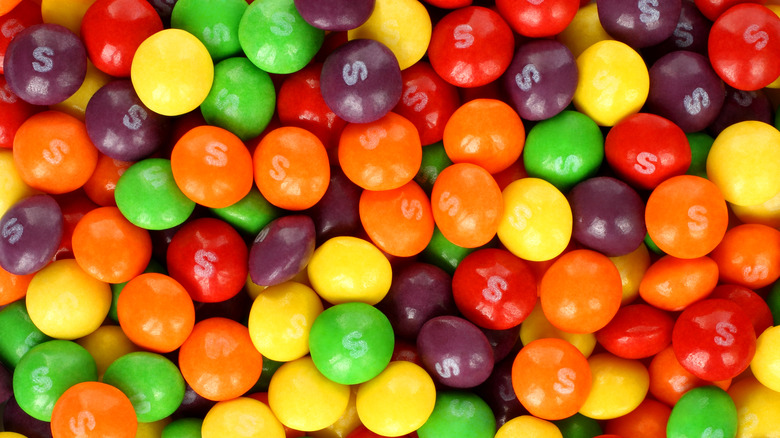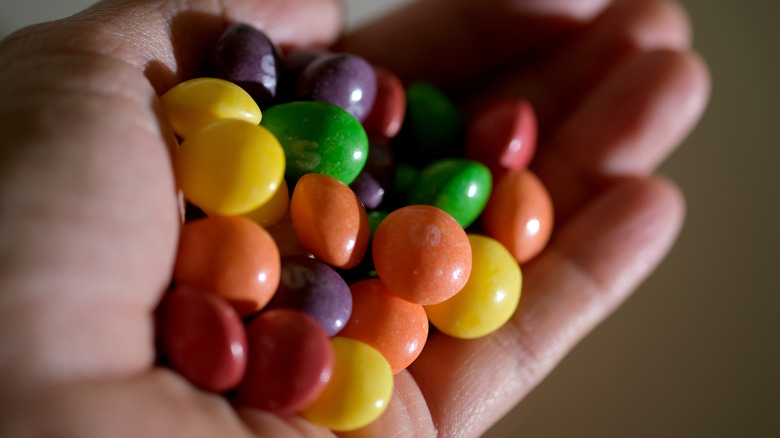Skittles Aren't All The Same Flavor, Right?
People have strong opinions about Skittles flavors. As a whole, the candy is almost universally beloved; in fact, Skittles were ranked as the most popular Halloween candy in America in the 2010s. However, when you get down to the individual flavors, things get quite divisive. Survey data collected by Skittles' parent company, Mars Wrigley, found that the most popular flavor of original Skittles is red or strawberry, preferred by 33% of respondents.
The same survey also found all kinds of wild correlations between people's favorite flavors and other personality traits, such as the fact that single people who prefer green Skittles are more likely to be ghosted by dates. Don't get too deep in the weeds analyzing your Skittles preferences, though. They might not be as unique as you think. According to some, all colors of Skittles are actually the same flavor.
This theory began circulating online in 2018 in the wake of an NPR report about the relationship between taste and sight. The results of a blind taste test indicated that people struggled to tell the difference between the flavors of Haribo gummy bears when they couldn't see the color. For more information, NPR interviewed neurophysiologist Don Katz, who dropped a major bombshell. "Skittles have different fragrances and colors," he said, "but they all taste exactly the same." This revelation sent the internet into a frenzy, but every color of Skittle tasting the same does not necessarily mean they're all the same flavor. The truth is much more complicated.
There's a difference between taste and flavor
We tend to use the words taste and flavor as if they were synonyms, but this isn't actually the case. Taste only refers to what we can sense through our taste buds. The average adult has somewhere between 2,000 and 10,000 taste buds spread around their tongue and palate, but their combined sensory power isn't as strong as you might think. Our taste buds can only perceive the five basic flavors of sweet, sour, salty, bitter, and umami — that's it. Obviously, the flavors we experience when eating and drinking are vastly more complex than that, so what else is happening?
Flavor actually refers to the combination of taste and smell. Our noses are capable of detecting around one trillion different scents, making them far more discerning than our tongues. In fact, as much as 80% of what we perceive as flavor actually comes from aroma. In Katz's interview with NPR, he said that every color of Skittle has the same taste, but he also said they each have different fragrances. Since fragrance has more to do with flavor than taste does, we can confidently say that every Skittle has its own flavor.
A spokesperson from Mars Wrigley also denied Katz's claim, insisting that each Skittle color had its own taste and flavor, but multiple Twitter users chimed in on the issue, claiming that they couldn't tell any difference between the candies if they plugged their noses while eating them.
How our senses can trick each other
The question of whether Skittles all taste the same or not has yet to be proven to the public, but it wouldn't be very hard for the manufacturers at Mars Wrigley to trick us all if they wanted to. Our senses are intertwined in such a complex way that it's hard to determine where specific flavors actually come from. Taste and smell are part of the equation, but that's not all.
You might have heard some people say that we eat with our eyes. This phrase is used to emphasize the importance of nice plating, but there's actually a lot more truth to it. Remember that the whole debate over whether all Skittles taste the same began with a gummy bear taste test that showed people couldn't differentiate between flavors if they couldn't see the color of the candy.
In addition to his tests on Skittles, Katz also conducted a study in which he added different fruit flavorings to bottles of water. Then, he added food coloring but intentionally put a misleading color in each bottle. Thus, the orange-colored water actually had grape flavor, and so on. When unsuspecting test subjects tasted the drinks, they got the flavors all wrong. To them, the orange drink tasted like orange. This confusion happens because our brains are conditioned to associate specific colors, smells, and tastes with certain flavors. In theory, Skittles could actually taste like nothing, but as long as the yellow one smells like lemon, we'll taste lemonade.


